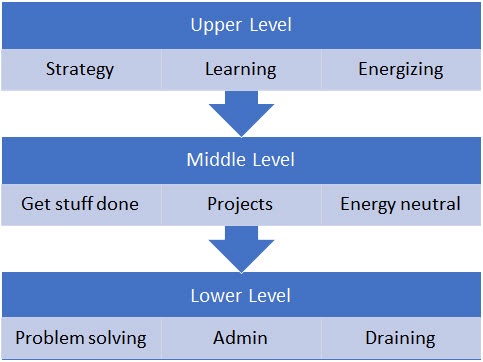On a recent coaching call with a European client who works with Fortune 500 CEOs and executive teams, we were discussing how the best executives manage their time, energy, and resources to generate results.
From my perspective, there are three levels of how executives function that drives where they spend their time. The structure is not complicated: upper level, middle level, and lower level. Unfortunately, the lower levels have much stronger gravitational pull than the upper level.

How much time are you spending at each level? If you’re not sure, look at your calendar and see what you’ve got scheduled. I’ll bet you a lunch that most of your time, if scheduled at all, is spent on middle and lower level activities.
Why is it that you don’t spend one-third of your time on higher level thinking and development? It might be because thinking is hard work. Or, you’ve got more pressing problems to fix and you’re the best person to fix them.
Fixing things can give you an immediate sense of accomplishment today but it’s not going to help you achieve strategic initiatives tomorrow.
I recommend spending at least one-third of your time in the upper level, no more than one-third of your time in the middle level, and as little as possible in the lower level.
If you’ve got extra time available, don’t fill it with more work! Go for a walk, call a friend, or go to an art gallery. Do something that recharges your brain and your heart.
Unfortunately, we tend to fill any time vacancies with tasks.
The middle level is where stuff gets done. It’s about managing people and projects to take care of customers. It’s the routine day-to-day tasks that provide value for customers. But it’s not where strategic growth and value creation occur.
Some people mistake middle level activities and inputs for results and outputs. Be careful that you’re not spending time here for a false sense of security that accompanies getting something done. That thing you got done probably could have, and should have, been done by one of your managers.
The lower level is spent fixing problems, doing administration, and other menial or low value tasks that should be avoided at all costs.
If you’re the CEO and your time is costing your company $200 per hour and you’re doing the work of someone that costs $50 per hour, you’ve got two problems. One is the financial loss. The second is the strategic loss because you’re not focused on what you need to focus on and neither is anyone else, because there is only one CEO.
| The CEO Weekly Time Quiz | ||
| Upper Level: | ___% scheduled; | ___% actual |
| Middle Level: | ___% scheduled; | ___% actual |
| Lower Level: | ___% scheduled; | ___% actual |
Operational Gravity
Operational gravity is especially dangerous because it will always try to drag you down to the lowest level where problems need to be fixed and the urgent overpowers the important.
Here is the real killer of growth…The opportunity cost of spending time in the lower level is that you’re not spending it in the upper level. Lower level activities also burn up your energy, enthusiasm, and talent. Lower level activities prevent you from creating an ideal future for your business and your clients’ businesses.
The key to resisting operational gravity is to proactively schedule your time, protect your time, and honor your time to work on upper level activities. Saying no helps. Being less accessible helps.
Is it you?
Isn’t it amazing how your employees get work done when you are away on a business trip or vacation? Isn’t it interesting how busy you are when you return doing work that was done by other people when you were away? If they could do it when you were gone, how come they can’t do it when you returned?
The Upper Level
You will know you’re working on upper level activities because:
- you feel energized, time flies, and it doesn’t feel like work
- you’re learning new things about your customers or competitors
- you’re creating and selling new products and services
- you’re connecting with people, and
- you’re taking risks and growing.
Creating an ideal future is the most important part of strategy. Strategy is the result of spending time in the upper level of executive function.

